Coronavirus: Trump’s New Reality Show
Trump was tiring before COVID-19, now he’s constantly taking his audience on a rollercoaster ride. At a March 24th press meeting, a reporter asks Trump – who suggested Easter as the date when the country could go back to work? Trump responds – “I just thought it was a beautiful time, a beautiful timeline. It’s a great day…”
As late as March 27th, Trump remained hopeful that the country would go back to work on April 12th Easter Sunday. Then two days later on March 29th, Trump states that social distancing is to continue through April 30th. The ignorant but “beautiful” Easter timeline, he now refers to as “aspirational.”
Why does anyone take what this guy says seriously and more importantly, why does the media continue to air him? KUOW of Seattle has taken the correct stance: “KUOW recently made an editorial decision to stop airing White House briefings on the coronavirus pandemic live on a daily basis. We will continue to cover these briefings – but believe it is imperative that they are fact-checked, which is a challenge during a live broadcast.”
When not reading a script, Trump says what pops into his head while a country is listening, this is incredibly irresponsible. Later, he is corrected by the numbers and experts, but rather than recognizing his ignorant statements, he reframes them and blames the Media as fake news. Meanwhile, there are still people listening to him. Trump creates false expectations and takes people on a rollercoaster ride unnecessarily at a time when it’s best to take the long view and prepare people for the most factual possibilities, not false realities based on his whims. Of course, as a born millionaire who has never dealt with reality, he’s accustomed to creating his own televised realities, and he’s at it now, he can’t help it. However, now there is a pandemic and people are dying. This man should be held accountable for making shit up and not properly preparing this country in January 2020.
Question of Intelligence
Before COVID-19 shutdown New York City, I had the opportunity to experience the exhibition “The Question of Intelligence – AI and the Future of Humanity” curated by Christiane Paul at Parson’s Kellen Gallery. I did not enter the exhibition expecting to witness disparate algorithms animating the exhibition space. It took me a few minutes to realize that the empty gallery (populated only by myself and two silent gallery sitters busily working, I suppose, on their school work) was brought to life by artworks forced to listen to one another and respond. I’m talking about artworks sensing via microphones, cameras, the internet; processing through artificial intelligence, machine learning, algorithms; and communicating via speakers, projectors, screens, printers, the internet and miniature swamps.
Christiane Paul has assembled elder artificial intelligence artworks over 40 years old (though still learning) with nascent works just starting to realize themselves. With the popular explosion of catch phrases including “Big Data,” “AI,” “Machine Learning,” “Today, right now, you have more power at your finger tips than entire generations that came before you…” (I used to appreciate Common before the Microsoft commercial, now I cringe when I hear his voice), Paul has curated a learning experience that recognizes the generational history of artificial intelligence as a creative medium.
Upon entering the gallery, one hears female artificial voices generating poetry or relating temperatures and soil humidity and other environmental measures or in the distance an occasional tweet. To the left, I saw a big black microphone and elected to approach it as the first means toward interactivity. I introduced myself and then watched my words projected onto the wall along with Chinese-style landscape paintings. Trails are drawn from word groupings to word groupings along with drawn landscapes and icons forming a word and image map. The projection is a mind map generator based on the words captured by the microphone. Following a few phrases, I decided it wasn’t very interesting and decided to move on. Adjacent to it is Lynn Hershman Leeson’s chatbot Agent Ruby (2001), but having interacted with one of Leeson’s works at Yerba Buena’s “The Body Electric” recently, I only spent a minute with it before moving on, also it didn’t know what to make of what I was telling it.

Adjacent to the chatbot, is Lior Zalmanson’s “image may contain” in which the artist feeds historically significant images into FaceBook’s Automatic Alternative Text image recognition algorithm, an accessibility AI to help contextualize images for the blind and sight impaired. The artists uses the uncontextualized and minimal description of the historical images to identify “similar” images and then collapses them onto lenticular prints. Above are the images that appear in the first print as I move from left to right. The work simply and clearly shows that bots such as AAT should not be used to present information and least of all pretend to be a source of knowledge, at least not yet.
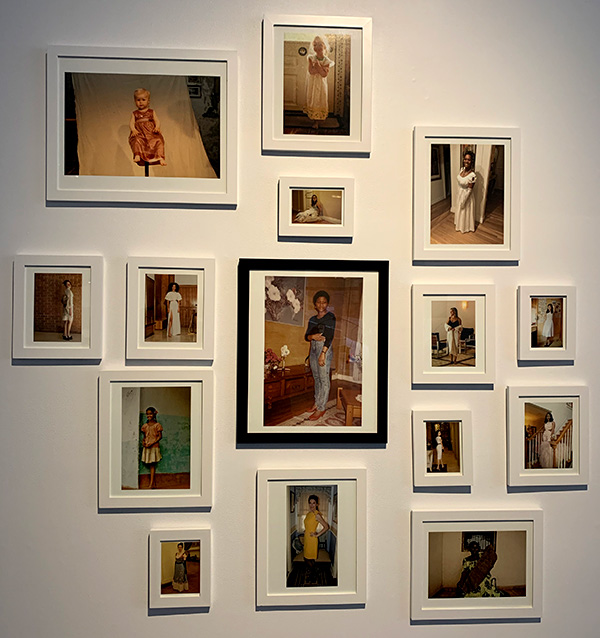
Similarly, Mimi Onuoha uploaded a photo of her mother “to Google’s reverse image search, which allows one to upload a picture to find online images that the Google algorithms identify as related.” Scaled, printed and framed from the initial image at the center to the algorithmically related images encircling, a seemingly family home portrait wall appears, leading one to question the process of algorithmic categorization based entirely on visual similarity. With such a project, I can’t help but recall eugenics and Sekula’s “The Body and the Archive.”
I then circled back toward the center of the gallery to try and figure out what was going on with “The Giver of Names” by David Rokeby. And it wasn’t until I read the instructions and changed the objects on the pedestal to assemble my own still life that the brilliance of the exhibition really dawned on me!
“The Giver of Names” (naming since 1990) consists of a monitor, speaker, old CCTV camera, pedestal, pile of old toys and a program that tries to understand what it is seeing through the camera to generate poetry. Once I removed the toys left on the pedestal and placed my own selection, I watched the AI go into action by identifying shapes and colors and then trying to make sense of what it was identifying or “seeing.” Those shapes and colors feed a poetry algorithm that speaks and writes to the monitor adjacent to the CCTV camera. Meanwhile, just beyond this installation, the not very interesting mind mapping microphone is also capturing this generated poetry as it echoes across the gallery and starts mind mapping away. AWESOME! The gallery is its own loop of machines churning away at one another’s utterances. This realization helped me refocus my attention and expand my time with each work. I tried to capture this in the video at the top of this entry.
Near the entrance on a wall monitor, hangs AARON which I had merely paused at for a few seconds but now returned to observe. “AARON is the earliest artificial intelligence program for artmaking and one of the longest running ongoing projects in contemporary art. Harold Cohen started creating AARON at UCSD in the late 1960s and developed the software until his death in 2016. In this video AARON produces a new color image every 10 to 15 minutes.” As one tours the gallery, AARON is quietly working away creating shapes and lines of color, artful abstractions.
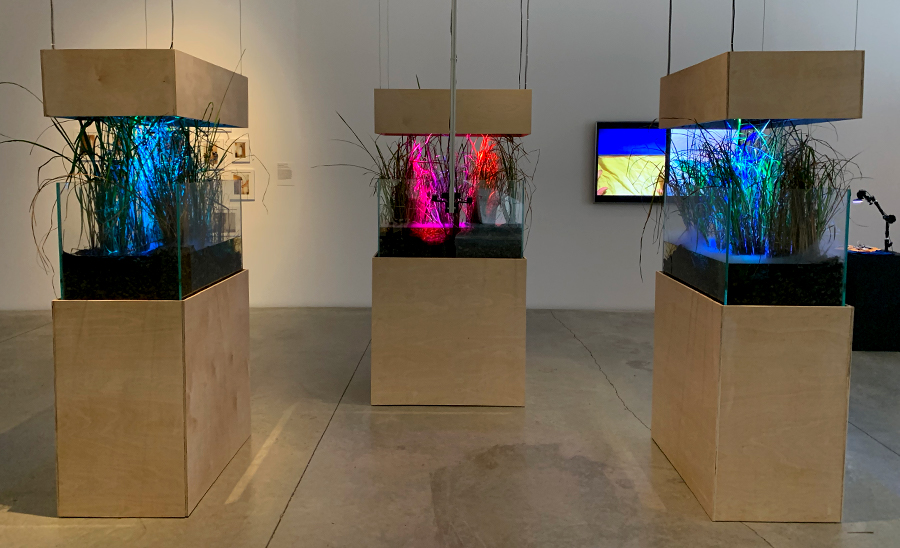
Back near the center of the gallery, just beyond “The Giver of Names” is another work with a female computer voice speaking at intervals. Tega Brain’s “Deep Swamp” asks “if new ‘wilderness’ is the absence of explicit human intervention, what would it mean to have autonomous computational systems sustain wild places?” The handsome installation has three AIs, Nicholas, Hans and Harrison each “engineer their environment for different goals. Harrison aims for a natural looking wetland, Hans is trying to produce a work of art and Nicholas simply wants attention.”
“Learning to See” by Memo Akten uses machine learning to relate the objects on a pedestal that a camera captures to five different data sets that the system has been fed. The visitor can re-arrange the objects on the pedestal to see new interpretations. Across from the pedestal on a wall is a split screen that shows the image captured by the camera adjacent to the system’s interpretation. “Every 30 seconds the scene changes between different networks trained on five different datasets: ocean and waves, clouds and sky, fire and flowers, and images from the Hubble Space telescope.
Similarly across the gallery, hang a series of prints by Mary Flanagan. The work is [Grace:AI] in which generative algorithms trained on thousands of paintings and drawings by women to create a series of images. “[Grace:AI] was tasked to create her ‘origin story’ by looking at 20,000 online images of Frankenstein’s monster and producing its portrait.”
Both “Learning to See” and “[Grace:AI]” employ generative adversarial networks (GAN), to generate new visualizations. Using GAN anyone can put their own conceptual spin to generate a data set for the machine to learn and see what it spits out. Over the last few years, I’ve seen a few similar projects, my favorite remains an early one – the MEOW Generator trained on a cat dataset.
Perhaps the most darkly monumental project are the large four black machines with spinning fans, exuding steam and ticker tape – the installation component of #BitSoil Tax by LarbitsSisters. The project proposes the fair redistribution of internet wealth to all people through a new taxation system. The installation is utopian, dark and whimsical.
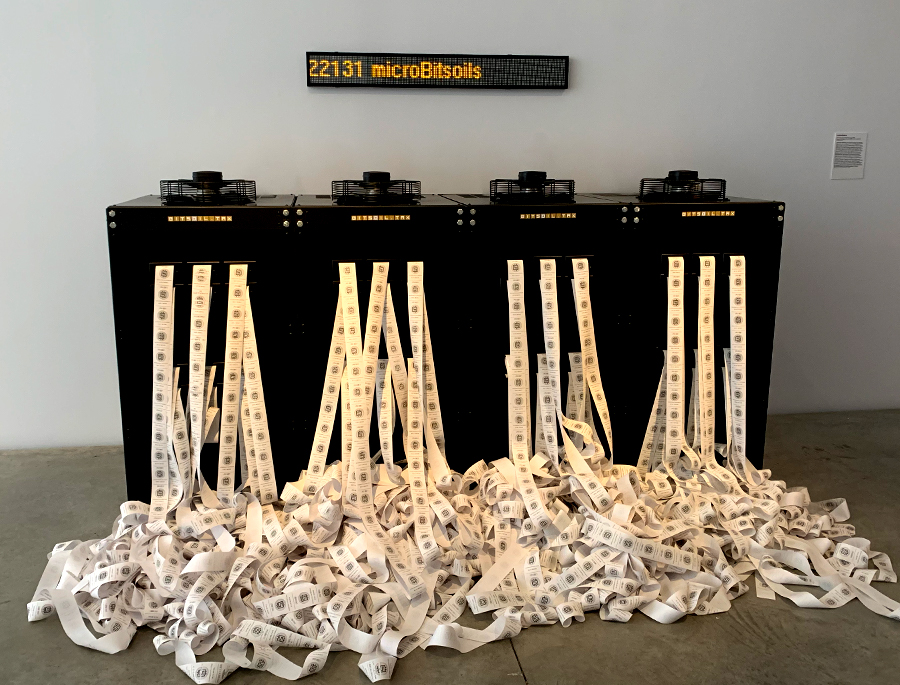
Other projects on exhibit include “Futures of Work” by Brett Wallace, and Ken Goldberg and the AlphaGarden Collective.
ICE Rushes to Return Detained Migrants as Need for Laborers Soars
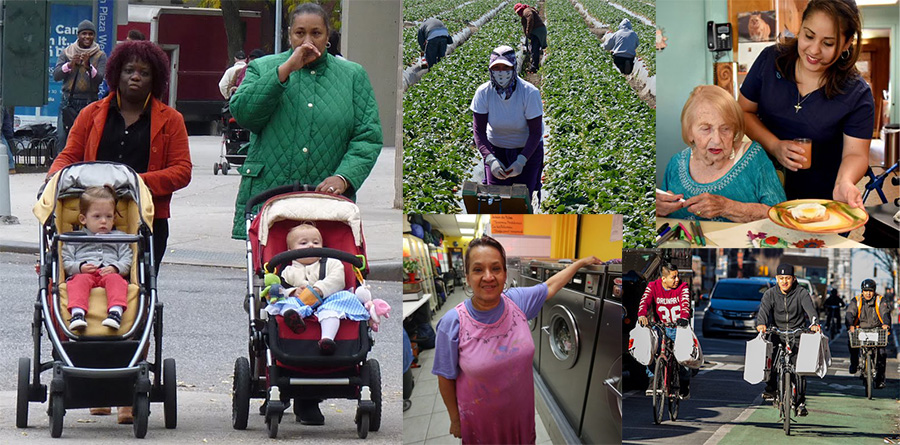
I’m waiting to read the following headlines “ICE Rushes to Return Detained Migrants as Need for Laborers Soars” and “The Federal Government Will Provide Health Care and Sick Leave to Undocumented Work Force.” If we use the San Francisco Department of Public Health order for “SHELTER IN PLACE” declared yesterday, a majority of the “Essential Businesses” are manned my immigrants:
- Grocery stores, farmers’ markets, supermarkets;
- Food cultivation, including farming, livestock and fishing;
- Gas stations, auto-supply and auto-repair;
- Laundromats, dry cleaners, and laundry services;
- Restaurants and other facilities that prepare and serve food, but only for delivery or carry out;
- Home-based care for seniors, adults, or children;
- Plumbers, electricians, exterminators, and other service providers;
- Businesses that ship or deliver groceries, food, goods or services directly to residences;
- Taxis, transport workers;
- Childcare facilities;
Each of these areas and more are now considered Essential Businesses that are fulfilled by Essential Function Workers. As I read through the list, these are jobs that immigrants are commonly the employees; not only immigrants but many undocumented immigrants. Consider your food delivery guys, the childcare nannies, the laundromat and dry cleaning employees, the senior care employees, farm workers (40-50% are undocumented)… Over the last few years, the undocumented immigrant workforce has been at rising risk of losing the lives they have fought to construct in this country as ICE has ramped up raids. Now, as CORONAVIRUS runs its course across the United States, there will be an increasing need for this immigrant labor force.
Unfortunately the country’s social net has deteriorated over the last forty years of rampant neoliberalism and increasing inequality. Suddenly, Trump’s tax cut and slashing of the social welfare will have significant ramifications. I wonder what support these essential laborers will be given if they become sick and can no longer go to work. If we are calling the food delivery workers, farm workers, supermarket employees, laundromat employees, delivery workers (Amazon plans to hire a new thousand), gas station employees, Uber/taxi driver, home caretaker – essential function workers – will the country help them if they become ill? All the laborers that do not have green cards or work permit or social security number – what support will they be given for risking their lives?
Hole in the Meadow
The hole suddenly opened up in the middle of the park! Right at 7:30am, last Tuesday a hole grew from nothing to a 30 meter radius at the center of the north side of the Long Meadow. It occurred in an instance. At least 30 frolicking dogs disappeared into it. Fortunately, the majority of the owners happen to be standing along the perimeter; so perhaps only 10 owners died or rather disappeared upon the appearance of the hole. And then there were five more or so that flung themselves into the hole after their dogs. Most stood mouths agape or collapsed to their knees blindly staring into the abyss.
Now the military has cordoned off the north section of the Long Meadow and a team of investigators descended down the hole on ropes from military helicopters. When the ropes were reeled back up, they were empty. Zero communication has emanated from the hole. Meanwhile, the owners of the lost dogs and their friends have placed memorials along the perimeter of the cordoned area. Flowers, dog portraits, favorite dog toys, bones, sticks, leashes and even a few statues form the doggy memorial border.
Cuban Girlfriend for Rent
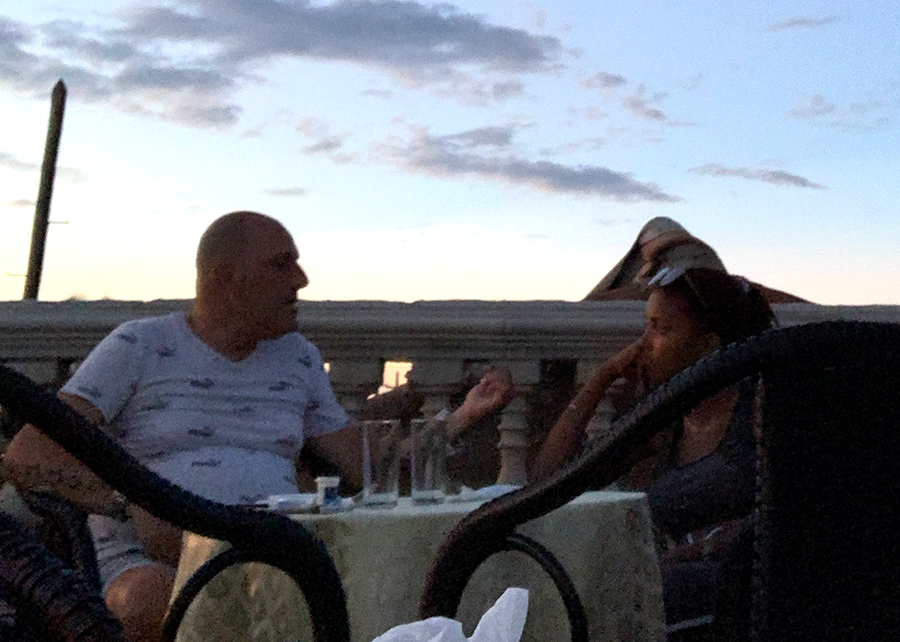
Friday April 26th, 2019, I had arrived in Camaguey, Cuba the previous day for the city’s video art biennial. Earlier this day, I presented a virtual reality piece – “Incertidumbre” outside the biennial’s theater – on the street in a small public square. It was a big hit with unsuspecting pedestrians, not so much because of the content, but rather because no one had tried virtual reality, so people were awed. Throughout the two-hour duration of presenting the work, there was a line, so that evening I decided to treat myself to a nice dinner at a restaurant that I had enjoyed on my last visit to the same biennial. I requested a seat on the rooftop deck as it was not too hot and I could enjoy the view of the city with its rooftop ceramic tiles and many church towers as the sun set.
I had the patio to myself until a couple arrived – a man perhaps near 50 with a young woman, perhaps in her late teens. As I was alone, I couldn’t help but overhear their conversation. He spoke with an Argentinian accent as he told her about his latest travels – business travels around Western Europe and South America. His voice was deep and aggressive, not particularly pleasant to listen to. He was a large bald white man who stood over six feet with a decent belly and skinny legs. His v-neck t-shirt with a pattern of sailboats was a bit too tight. She was a beautiful light-black young woman with an hourglass figure. Her large firm breasts shaped nicely her fitted dark tank top.
The large bald white man talked about flying first class, the delicious champagnes that he was served. He told her that in first class the seats fully recline. He would down three or four champagne glasses, transform his seat into a bed and put himself to sleep. He told her about the sporty BMW that he rented to travel around Spain as he had meetings in Madrid and Seville. He said his business was doing well, described how busy he has been, and that he was glad to be back in Camaguey to relax. He talked on and on while she remarked in awe but with a tinge of boredom. For the most part, she merely listened. Until he paused with a complaint – that he had been telling her all about his life and travels and she had not told him about her life – what she has been up to, details of her life…
At this she replied with a hint of frustration – “you already know all about my life. I get up, go to school, after school, I do sports until it’s time to go home for dinner, and then I study until it’s time to go to bed… That is my life, I don’t go out, because I’m too busy with school and athletics. I’ve already told you all this…”
At this point, I couldn’t help myself but shift my chair a bit and pretend to take a selfie with them in the background. It was a stereotypical reality that one hears about and sees upon visiting Cuba – older men from abroad paying girls for their time and bodies. It was clear that they knew each other and that they are together when he is in Camaguey. Perhaps he maintains her by regularly sending her money and in exchange she is his when he is in town.
I finished my dinner, particularly enjoying the plantains stuffed with shrimp. I had had those before and upon entering the restaurant, they immediately came to mind. I requested the bill from one of the waitresses – two and at times three had been hanging around the patio as the downstairs was empty and the only patrons were myself and the older bald white man with the beautiful girl.
The Joy of Punk Rock
This past Saturday (20 April, 2019), I got to experience a bit of Rock ‘n’ Roll history as Half Japanese celebrated a re-release of their 1988 “Charmed Life” album on blue vinyl. Long before the popularization of the genres Indie Rock or Alternative Rock, the brothers Jad and David Fair formed the punk rock band Half Japanese in 1975. But when one listens to Half Japanese now, it doesn’t identify with 70s punk as much as 80s and 90s alternative rock. Between the lyrics, distorted guitar and noise, the first band that comes to mind is Sonic Youth who have cited Half Japanese as an influence and Don Fleming who has worked with Sonic Youth was on stage.
I only had my iPhone and generally would not use it to record song after song, but I felt as if I was listening to something special as these white haired men in their 60s rocked out on the small stage of le poisson rouge. Between the darkness of the club and the fluctuating lights on stage, much of this footage is a blur, but you can still hear the art punk sounds of Half Japanese.
Reza Aramesh at Asia Society
Iranian born artist Reza Aramesh (b 1970) has a powerful one room installation at the Asia Society in New York City. The power of the work is not so much in the sculptures, but rather at what they point to through their titles:
Action 131: Dying Iranian Soldier, 1987
Action 134: December 31, 1980, Ankara, Turkey
Action 133: Dying American Solder, Baghdad, Iraq, Tuesday, 9 November 2004
Action 132: Saigon, 5 August 1963
Decades of warfare, decades of death, the savagery of mankind as perpetrated by one empire upon a series of much weaker nation states – Vietnam, Turkey, Iran, Iraq… The sculptures are engaging and beautifully executed, but it was not until I read the titles that I realized what I was beholding; then the work resonated.
The male figures frozen in agony become individual victims of war. And just in case one does not read the titles, inspection of the wallpaper lining the entire room will make the subject of the installation abundantly clear. At the center of the wallpaper pattern is a hooded and bound figure – so called “enemy combatants” surrounded by four naked male figures depicted from behind. The naked figures leave one wondering – are they dead soldiers walking to the afterlife or soldiers stripped of their identity and beliefs for their country’s ideology? The only figure in the illustration that faces the viewer is the bound and hooded central figure. A close up of the wall paper is pictured below.
The installation is simple and powerful. I only question the brown velvet garment that drapes over the lower part of each torso. The garment itself is fine and effectively points to religious sculptures, however the awkward shape of the pedestals that lie hidden below the garment do not flow naturally to the torsos, so the pedestals stand out as unresolved presentation. That said, concept and craft come across powerfully in this room.
Nicaraguan LGBTQ Community
I recently read the essay “Tacit Subjects” by Carlos Ulises Decena in which the author interviews several homosexual individuals from the Dominican Republic. Decena focuses on the coming out or not of gay Dominican men to their families. Amongst the subjects interviewed for the essay, their homosexuality is unspoken but recognized by their family members, hence the title “Tacit Subjects.”
Upon reading the essay, I was immediately transported to the awe that I felt in 1995 upon witnessing my first Torovenado in Masaya, Nicaragua. Throughout my life I had only visited Nicaragua during the summer and I had enjoyed the initial celebrations of the three month festivities for San Jeronimo, the patron saint of my mom’s hometown – Masaya. El Torovenado – a satirical procession occurs at the end of the celebrations – the final Sunday of October. In 1995, I moved to Nicaragua for an extended period and the uncle with whom I was living, invited to take me to El Torovenado. Mi Tio Jorge enjoys a good party and is not particularly religious, so I was a little surprised that he’d want to go to the culmination of a saint’s festivities. However, I noted a mischievous spark in his eye and I agreed to join him on the 20 minute drive to Masaya.
I was dumbfounded upon seeing a giant gay parade in my mom’s hometown. It was as if the San Francisco Castro that I grew up with had transported itself to Masaya. There, before me, was the Lion’s Club (El Club de Leones) Queen – queen of the parade – a proper queen, entirely in beautiful drag. Everywhere I looked the rainbow flag was flying high. I think my uncle truly enjoyed at how speechless I was.
The culmination of this Catholic festivity had been co-opted by the gay community and everyone appeared to be fine with it. Since El Torovenado is a satirical procession in which people are allowed to mock anything and everyone – from historical figures to the most powerful political figures, in retrospect, it makes sense that the gay community took over this particular day of celebration; after all it’s a day of freedom, when social norms are discarded. El Torovenado is alternately called La Parada de los Cochones.
I feel that Nicaragua has always been more accepting of its gay community than other Latin American countries and I think that the 1979 victory of the Sandinistas allowed greater freedom for the LGBTQ communities through the 80s. The Torovenado allows the large numbers of the gay community to gather and party. Here is a 5 minute video documentation of the 2017 Torovenado (before the current Ortegista repression and militarization of the country):
In relation to the gay Dominicans featured in “Tacit Subjects,” these are people (primarily men) who are out and proud and the public persona that they present particularly in a festive procession may be very different than who they are with their family. Perhaps the acceptance of the gay community in Nicaragua allows young people to come out and discuss sexuality more openly than in the DR and it is not such a tacit subject. However, macho culture exists as in the rest of Latin America and I would not be surprised if a large portion of this community is alienated from their birth families and have constructed or adopted new families based on their sexuality.
There is an interesting book that I’ve only read passages from that goes in depth regarding the gay community following the Sandinista revolution – Intimate Activism: The Struggle for Sexual Rights in Postrevolutionary Nicaragua by Cymene Howe. The book discusses El Torovenado:
according to Erick Blandon, the Torovenado is a ‘moment of escape from oppressive heterosexual masculinity and a dialogic engagement between different sexual subjects where homoeroticism becomes the center of attention for both homosexuals and heterosexuals.’ While transvestics are not the quotidian norm in Nicaragua, it is clear that the country has had a public and symbolic space for these kinds of gendered performances.
Howe, Cymene, Intimate Activism: The Struggle for Sexual Rights in Postrevolutionary Nicaragua, Duke University Press, 2013
With the current violence and repression by the Ortega dictatorship, I wonder how the LGBTQ community is doing. Have they become a tacit community? Are they remaining in-doors as does the majority of the population come nightfall? The LGBTQ Nicaraguan population has largely thrived due to the safety and acceptance of the country, but with assassins trolling the streets, freedom and expressiveness may no longer be available. It is so sad that the military leaders will allow a single couple – Ortega and Murillo hold an entire country hostage and have destroyed the legacy of a popular revolution.
1000 icons Featured in Web-Retro
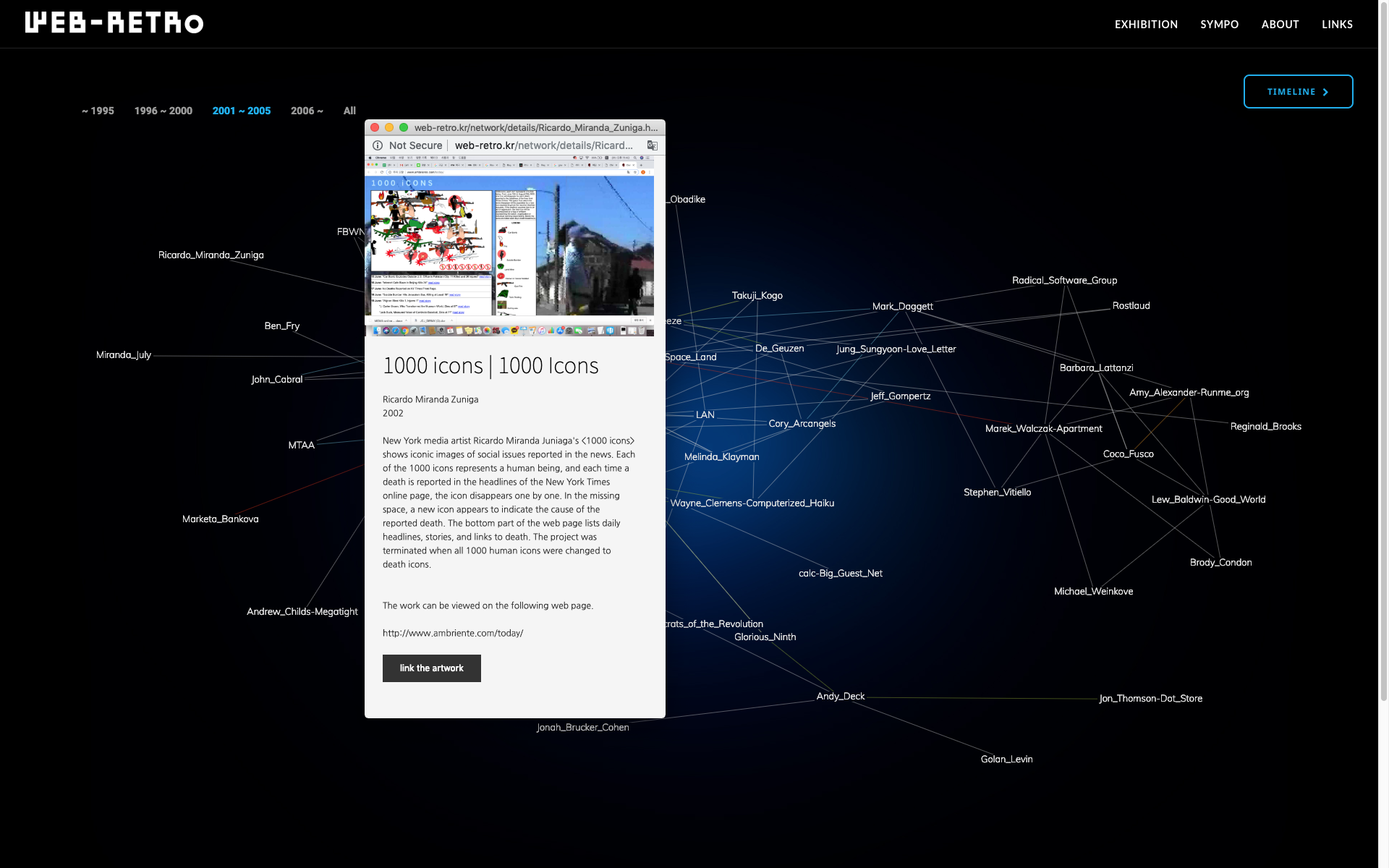
On the 30th birthday of the World Wide Web, the Seoul Museum of Contemporary Art launched WEB-RETRO, an “exhibition focuses on the World Wide Web, which has been fundamentally reconditioning communication, image production, consumption and artistic practice for the last 30 years, and revises the new arts that have been tried through the net historically.”
Included in the exhibition is the net.art visualization 1000 icons. From June 15th to August 25th 2002, one human icon (of a thousand) disappeared for each death reported in the headlines of the New York Times Online. The human icon was replaced by a new icon representing how the reported death(s) occurred. Upon consuming the NY Times headlines, I would illustrate an icon based on any deaths covered amongst the top headlines. If the death(s) occurred due to an act of aggression, the new icon was accompanied by a flag or emblem representing the nation or organization claiming responsibility. Below the icons are listed each day’s death NY Times headline(s). This project came about due to the Second Intifada – an intensified period of Israeli-Palestinian violence and the citing of daily death in news headlines.
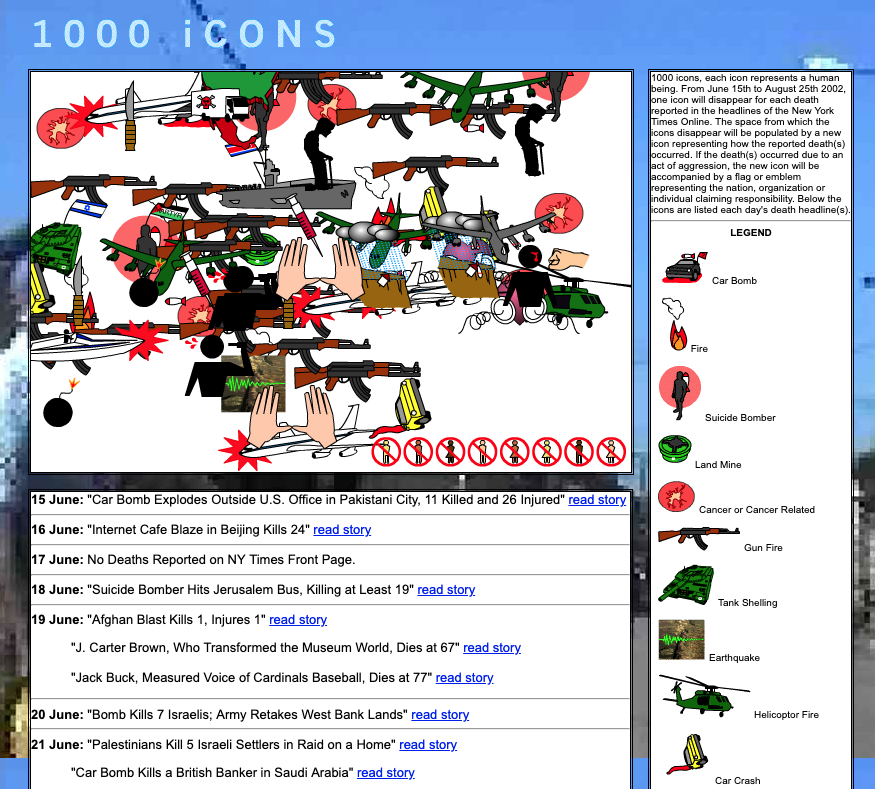
JAMES ARONSON AWARDS
Call for Submissions Deadline – March 18, 2019 for the James Aronson Awards for Social Justice Journalism & Cartooning with a Conscience.
Individual reporters, cartoonists and publications are encouraged to submit work. We are thrilled that the Aronson Awards is entering its 29th year of celebrating outstanding and risk taking journalism. Since 1990, the Aronson Awards have honored original, written reporting that exposes widespread injustices, underlying causes, and possible reforms. This includes exposing discrimination based on race, class, gender, religion or sexual orientation; economic exploitation; violations of human rights, civil liberties or free expression; environmental degradation; and brutality to civilians in war.
The Aronson Awards recognize original work published in English in newspapers, magazines, blogs and online publications based in the U.S. A separate prize, the Grambs Aronson Award for Cartooning with a Conscience, recognizes the achievements of political cartoonists whose work focuses on social issues. Individual reporters, cartoonists and publications are encouraged to submit your work.
Entry Forms: http://aronsonawards.com
The Aronson Awards are administered by the Hunter College Department of Film & Media Studies.
Directors
Tami Gold & Blanca Vazquez
718 801-0381
tamigold@mindspring.com